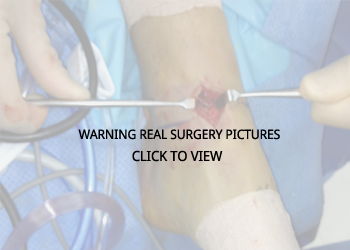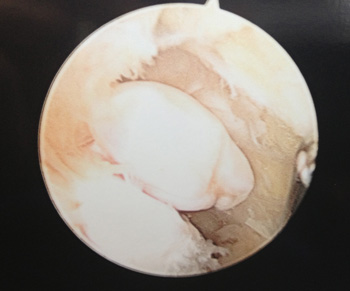(877) 977-1443
Conditions
- Ankle Arthritis
- Ankle Ligament Tear (Sprain)
- Ankle Fractures (Broken Ankle)
- Flat Feet
- Tarsal Coalition
Advanced Treatments
- Regenerative Medicine
- Ankle Arthroscopy
- Total Ankle Replacement
- Ankle Fusion
- Ankle Cartilage Replacement
- Custom Orthotics
- Physical Therapy
- Lifestyle Changes
Education and Articles
Trusted Podiatrists

Ankle Cartilage Replacement
Ankle Cartilage Replacement
Cartilage replacement is commonly done for small defects of cartilage in the ankle joint. These small defects of cartilage are called "osteochondral lesions". These lesions are frequently found in patients with chronic instability of the ankle and in patients with acute ankle fractures or sprains.There are several options for cartilage replacement and use often will depend on the size and depth of the lesion. The Ankle Arthritis Institute at UFAI is proud to be a leading organization in cartilage replacement.

From juvenile cartilage replacement with the Denovo procedure to cartilage grafting to bone and cartilage plug replacement, we offer the latest options and techniques. Our commitment to restoration of function with a limitation of joint loss has progressed us to amazing cartilage replacement cases with full return to function.
In certain cases of cyst formation of large arthritis damage, cartilage replacement may take on block transfers. In these cases, the block of damaged bone is removed and a cadaver graft is used to replace the damaged cartilage, bone and cyst region. In such cases, coordination of graft material and size are essential for outstanding outcomes.

Microfracture surgery with ankle arthroscopy
Microfracture surgery is used in small lesions less than 1.0 cm in diameter that are superficial with no severe cyst formation of major bone damage. Microfracture may also be incorporated into more advanced techniques to treat part of the lesion or damage while transplant of cartilage is treating the other regions. This technique is often done arthroscopically, where a camera and instruments are inserted into the ankle through two small holes. After visualizing the lesion, holes are drilled in the osteochondral defect to penetrate the floor of the lesion and signal cells to migrate to the lesion. This stimulates revascularization/bleeding of the area and stimulates the production of fibrocartilage. Although not as mechanically stable as the natural hyaline cartilage that occurs in the ankle, fibrocartilage formation can help reduce pain and irritation of an osteochondral lesion, thereby providing symptomatic relief. In addition to microfracture, many other procedures can be done through an ankle arthroscopy.

Loose pieces of bone can be removed from the joint, joint spurring burred, joint inflammation can be treated, and scar tissue can be reduced in the ankle. The Ankle Arthritis Institute has advanced the microfracture technique by adding a restorative cocktail of platelet rich plasma, bone marrow stem cell concentrate and several other advanced materials to aide in the healing of osteochondral lesions with microfracture. The idea is simple; by adding the healing factors into the ankle joint at the end of the procedure, we are able to increase the bodies response to the damaged region and increase the healing potential. Our revolutionary "cocktail" is fast becoming the global standard for ankle osteochondral restorative treatments.

Denovo graft
Smaller osteochondral lesions (less than 1.5 cm in diameter) can be treated with a graft called Denovo. The osteochondral lesion has to be mainly involving superficial cartilage damage with little to no depth or bone damage. This graft is partilculated immature articular cartilage that is obtained from juvenile allograft donors up to 13 years of age. This graft has a high density of cartilage cells compared to mature adult cartilage and its application allows for cartilage growth within the osteochondral lesion. When applying this graft, the osteochondral lesion is cleaned up with an arthroscopic procedure or an open procedure. The shape of the osteochondral lesion is then molded and the graft, along with some biological glue, is placed in the mold and allowed to set. The graft and biological glue can then be placed into the lesion where it would sit flush and incorporate into the bone. The Ankle Arthritis Institute has advanced the Denovo cartilage transplant technique by adding a restorative cocktail of platelet rich plasma, bone marrow stem cell concentrate and several other advanced materials to aide in the healing of osteochondral lesions with microfracture. The idea is simple; by adding the healing factors into the ankle joint at the end of the procedure, we are able to increase the bodies response to the damaged region and increase the healing potential. Our revolutionary "cocktail" is fast becoming the global standard for ankle osteochondral restorative treatments.
Watch a Real Ankle Cartilage Replacement Surgery using the Denovo Technique
OATS (Osteochondral allograft transplant system)
Deep and larger lesions are usually treated with an osteochondral allograft. This is a graft is composed of mature hyaline cartilage that is used to replace the osteochondral cartilage defect. A donor bone matches the anatomic contour of the bone that has the defect is used for this procedure. Cartilage is punched out from the donor bone and then implanted into the area of the patient's bone that has defect. This graft will eventually incorporate into the patient's own bone. The graft should be harvested within 14 days of the surgery in order to maintain the viability of the cartilage cells. Frozen grafts are not recommended either also due to its effect of reducing cartilage viability.
Watch a Real Ankle Cartilage Surgery using the OATS Technique




